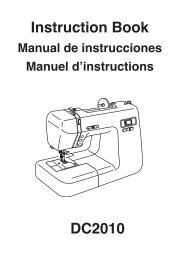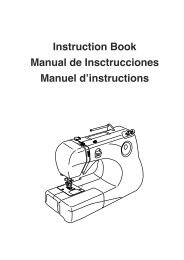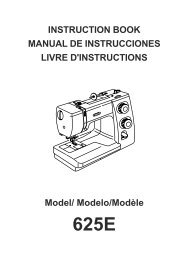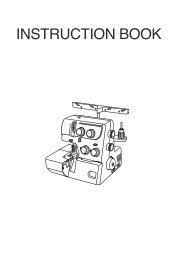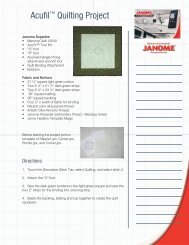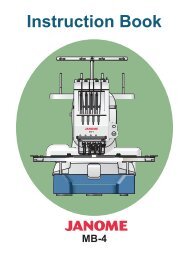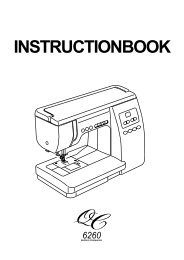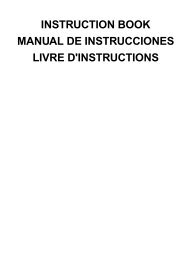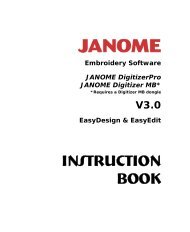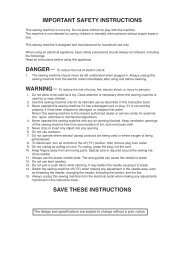HD3000 - Janome
HD3000 - Janome
HD3000 - Janome
You also want an ePaper? Increase the reach of your titles
YUMPU automatically turns print PDFs into web optimized ePapers that Google loves.
INSTRUCTION BOOK
IMPORTANT SAFETY<br />
INSTRUCTIONS<br />
This appliance is not intended for use by persons (including children) with<br />
reduced physical, sensory or mental capabilities, or lack of experience and<br />
knowledge, unless they have been given supervision or instruction concerning<br />
use of the appliance by a person responsible for their safety.<br />
Children should be supervised to ensure that they do not play with this<br />
sewing machine.<br />
When using an electrical appliance, basic safety precautions should always<br />
be followed, including the following:<br />
This sewing machine is designed and manufactured for household use only.<br />
Read all instructions before using this sewing machine.<br />
DANGER— To reduce the risk of electric shock:<br />
1. An appliance should never be left unattended when plugged in. Always<br />
unplug this sewing machine from the electric outlet immediately after<br />
using and before cleaning.<br />
2. Always unplug before replacing a sewing machine bulb. Replace bulb<br />
with same type rated 15 Watts.<br />
WARNING— To reduce the risk of burns, fire, electric<br />
shock, or injury to persons:<br />
1. Do not allow to be used as a toy. Close attention is necessary when this<br />
sewing machine is used by or near children.<br />
2. Use this appliance only for its intended use as described in this ownerʼs<br />
manual.<br />
Use only attachments recommended by the manufacturer as contained<br />
in this ownerʼs manual.<br />
The design and specifications are subject to change without a prior notice.<br />
3. Never operate this sewing machine if it has a damaged cord or<br />
plug, if it is not working properly, if it has been dropped or<br />
damaged, or dropped into water.<br />
Return this sewing machine to the nearest authorized dealer or<br />
service center for examination, repair, electrical or mechanical<br />
adjustment.<br />
4. Never operate the appliance with any air opening blocked.<br />
Keep ventilation openings of this sewing machine and foot<br />
controller free from accumulation of lint, dust and loose cloth.<br />
5. Never drop or insert any object into any opening.<br />
6. Do not use outdoors.<br />
7. Do not operate where aerosol (spray) products are being used<br />
or where oxygen is being administered.<br />
8. To disconnect, turn all controls to the off (“O”) position, then<br />
remove plug from outlet.<br />
9. Do not unplug by pulling on cord. To unplug, grasp the plug, not<br />
the cord.<br />
10. Keep fingers away from all moving parts. Special care is<br />
required around the sewing machine needle.<br />
11. Always use the proper needle plate. The wrong plate can cause<br />
the needle to break.<br />
12. Do not use bent needles.<br />
13. Do not pull or push fabric while stitching. It may deflect the<br />
needle causing it to break.<br />
14. Switch this sewing machine off (“O”) when making any<br />
adjustment in the needle area, such as threading the needle,<br />
changing the needle, threading the bobbin or changing the<br />
presser foot, and the like.<br />
15. Always unplug this sewing machine from the electrical outlet<br />
when removing covers, lubricating, or when making any other<br />
adjustments mentioned in this ownerʼs manual.<br />
SAVE THESE INSTRUCTIONS<br />
Please note that on disposal, this product must be safely recycled<br />
in accordance with relevant National legislation relating to<br />
electrical/electronic products. If in doubt please contact your<br />
retailer for guidance. (European Union only)<br />
1
Do’s and Don’ts<br />
1. Always be aware of the up-and-down movement of the needle and do not turn your attention<br />
from the machine while it is running.<br />
2. When leaving the sewing machine unattended, the main switch of the machine must be switched off<br />
or the plug must be removed from the socket-outlet.<br />
3. When servicing the sewing machine, or when removing covers or changing lamps, the machine<br />
must be disconnected from the supply by removing the plug from the socket-outlet.<br />
4. Do not place anything on the foot control, otherwise the machine will start inadvertently, or the<br />
control or motor may burn out.<br />
5. The maximum permissible power for the sewing lamp bulb is 15 watts.<br />
6. When using your sewing machine for the first time, place a piece of waste fabric under the<br />
presser foot and run the machine without thread for a few minutes. Wipe away any oil which<br />
may have appeared.<br />
2
TABLE OF CONTENTS<br />
SECTION I ESSENTIAL PARTS<br />
Names of Parts ............................................................................................4~5<br />
Foot Storage Compartment ............................................................................. 6<br />
Extension Table(Accessory Storage Box) ...................................................... 7<br />
SECTION II GETTING READY TO SEW<br />
Connecting the Machine to the Power Supply ................................................ 8<br />
Foot Control ..................................................................................................... 9<br />
Sewing Light .................................................................................................... 9<br />
Pressure Dial ................................................................................................. 10<br />
Dropping the Feed Dogs ............................................................................... 10<br />
To Snap On and Snap Off the Preser Foot ................................................... 11<br />
To Detach and Attach the Foot Holder ......................................................... 12<br />
Reverse Stitch Button .................................................................................... 12<br />
Seam Guide Line ........................................................................................... 12<br />
Changing Needle ........................................................................................... 13<br />
Thread and Needle Chart .............................................................................. 14<br />
Winding the Bobbin .................................................................................15~17<br />
Threading the Machine .................................................................................. 18<br />
Needle Threader........................................................................................... . 19<br />
Drawing Up Bobbin Thread ........................................................................... 20<br />
Balancing Needle Thread Tension ................................................................ 21<br />
Pattern Selector Dial ..................................................................................... 22<br />
Zigzag Width Control ..................................................................................... 22<br />
Stitch Length Control ..................................................................................... 22<br />
Variable Needle Position ............................................................................... 22<br />
SECCTION III BASIC SEWING<br />
Straight Stitch Sewing ................................................................................... 23<br />
Changing the Sewing Directions ................................................................... 24<br />
Straight Stitching on Heavy Fabrics .............................................................. 24<br />
Zigzag Stitch .................................................................................................. 25<br />
SECCTION IV UTILITY STITCHING<br />
Overcasting .................................................................................................... 25<br />
Overedge Stitch ............................................................................................. 26<br />
Tricot Stitch .................................................................................................... 26<br />
Triple Strength Stitich .................................................................................... 27<br />
Outline Stretch Stitich .................................................................................... 27<br />
Sewing Buttons .............................................................................................. 28<br />
Automatic Buttonhole .............................................................................. 29~31<br />
Manual Buttonhole ................................................................................... 32~33<br />
Corded Buttonhole ......................................................................................... 34<br />
Zipper Application .................................................................................... 35~37<br />
Rolled Hem .............................................................................................. 38~39<br />
Blind Stitch Hemming .................................................................................... 40<br />
SECCTION V DECORATIVE STITCHING<br />
Decorative Satin Stitch Patterns ................................................................... 41<br />
Stretch Stitch Patterns ................................................................................... 41<br />
Adjusting Stretch Stitch Balance ................................................................... 42<br />
Smocking ....................................................................................................... 42<br />
Quilting ........................................................................................................... 43<br />
Pin Tucking .................................................................................................... 44<br />
Shell Tuck ...................................................................................................... 45<br />
Fagoting ......................................................................................................... 45<br />
Applique ......................................................................................................... 46<br />
Patch Work .................................................................................................... 46<br />
SECCTION VI CARE OF YOUR MACHINE<br />
Cleaning the Bobbin Holder .......................................................................... 47<br />
Cleaning the Hook Race ............................................................................... 48<br />
Inserting the Bobbin Holder ........................................................................... 48<br />
Trouble Shooting ..................................................................................... 49~50<br />
3
SECTION I ESSENTIAL PARTS<br />
Names of Parts<br />
q Stitch length control<br />
w Zigzag width control<br />
e Bobbin winder stopper<br />
r Bobbin winder spindle<br />
t Foot storage compartment<br />
y Flip-top sewing instruction panel<br />
u Spool holder (large)<br />
i Spool pin<br />
o Top cover<br />
!0 Thread tension dial<br />
!1 Pressure dial<br />
!2 Face plate<br />
!3 Buttonhole lever<br />
!4 Thread cutter<br />
!5 Needle threader<br />
!6 Needle plate<br />
!7 Hook cover plate<br />
!8 Hook cover plate release button<br />
Extension table<br />
!9 (Accessory storage box)<br />
@0 Reverse stitch button<br />
!0<br />
!1<br />
!2<br />
!3<br />
!4<br />
!5<br />
!6<br />
!7<br />
o i u y t<br />
r<br />
e<br />
w<br />
q<br />
@0<br />
!8<br />
!9<br />
4
@2<br />
@3<br />
@4<br />
@1 @0<br />
#2<br />
#1<br />
#0<br />
@0 Thread take-up lever<br />
@1 Carrying handle<br />
@2 Handwheel<br />
@3 Clutch knob<br />
@4 Pattern selector dial<br />
@5 Feed balance dial<br />
@6 Power switch<br />
@7 Machine socket<br />
@8 Needle clamp screw<br />
@9 Drop feed lever<br />
#0 Free arm<br />
#1 Presser foot<br />
#2 Presser foot lifter<br />
@5<br />
@9<br />
@6<br />
@7<br />
@8<br />
5
Foot Storage Compartment<br />
q<br />
w<br />
e<br />
r<br />
Each presser foot and pocket is lettered for easy<br />
identification and storage. To achieve optimum<br />
sewing results, use the foot recommended for<br />
each sewing technique.<br />
u<br />
i<br />
t<br />
y<br />
q<br />
w<br />
e<br />
r<br />
t<br />
y<br />
u<br />
i<br />
o<br />
Needle case<br />
L. Quilter<br />
G. Blind stitch hem foot<br />
D. Hemmer foot<br />
C. Overedge foot<br />
E. Zipper foot<br />
B. Transparent buttonhole foot<br />
A. Zigzag foot<br />
R. Automatic buttonhole foot<br />
o<br />
<br />
The automatic buttonhole foot can be stored in the<br />
extension table.<br />
6
Extension Table (Accessory Storage Box)<br />
Extension Table<br />
Accessory storage box<br />
The extension table provides added sewing surface and can be easily<br />
removed for free arm sewing.<br />
For free arm sewing<br />
Lift out the extension table, as<br />
illustrated .<br />
For attaching the table<br />
Position the two pins of the<br />
storage box on the base slit and<br />
push down gently.<br />
¡ Sewing accessoires are conveniently<br />
located under the extension table.<br />
7
SECTION II GETTING READY TO SEW<br />
Connecting the Machine to the Power Supply<br />
Before connecting the power, make sure the voltage and frequency of your<br />
electrical power conform to the machine.<br />
Switch off the power, fit the nonreversible plug into the machine socket and<br />
plug the machine into the power supply.<br />
Switch on the power.<br />
While in operation, always keep your eyes on the sewing area, and do not<br />
touch any moving parts such as the thread take-up lever, handwheel<br />
or needle.<br />
Always turn off the power switch and unplug from the power supply:<br />
- when leaving the machine unattended.<br />
- when attaching or removing parts.<br />
- when cleaning the machine.<br />
Do not place anything on the foot control, otherwise the machine will<br />
run intermittently.<br />
Operating Instructions:<br />
The symbol "O" of a switch indicates the "off" position of a switch.<br />
For an appliance with a polarized plug (one blade wider than the other):<br />
To reduce the risk of electrical shock, this plug is intended to fit in a<br />
polarized outlet only one way.<br />
If it does not fit fully in the outlet, reverse the plug. If it still does not fit,<br />
contact a qualified electrician to install the proper outlet.<br />
Do not modify the plug in any way.<br />
The foot controller Model YC-482J or TJC-150 is used with this sewing<br />
machine (USA market only).<br />
8
Foot Control<br />
Sewing Light<br />
Sewing speed can be varied by the foot control.<br />
The harder you press on the control, the faster the<br />
machine runs.<br />
The sewing light is located behind the<br />
face plate.<br />
[To replace the bulb]<br />
(A) • To remove.........Turn to the left.<br />
• To replace.........Turn to the right.<br />
(B) • To remove.........Push and twist to<br />
the left.<br />
• To replace.........Push and twist to<br />
the right.<br />
NOTE: When replacing the bulb, unplug<br />
the machine.<br />
9
Pressure Dial<br />
Dropping the Feed Dogs<br />
Drop feed lever is located underneath of<br />
free arm bed.<br />
The pressure dial should be set at “3” for regular sewing. Reduce<br />
the pressure to “2” for appliques.<br />
Set the pressure to “1” when sewing chiffon, lace, organdy and<br />
other fine fabrics. Velours and knits with a lot of stretch may also<br />
require a “1” setting.<br />
To raise the feed<br />
dogs, push the<br />
lever to the<br />
direction of arrow<br />
as illustrated.<br />
For dropping the<br />
feed dogs, push<br />
the lever to the<br />
direction of arrow<br />
as illustrated.<br />
* Feed dogs must always be up for normal sewing.<br />
10
To Snap On and Snap Off the Presser Foot<br />
To snap off<br />
To snap on<br />
Additional Clearance<br />
Turn the handwheel toward you to<br />
raise the needle to its highest<br />
position. Raise the presser foot.<br />
Press the lever on the back of the<br />
foot holder.<br />
The presser foot will drop off.<br />
When attaching the presser foot,<br />
the pressure dial should always be<br />
at position “3”.<br />
Place the presser foot so the pin<br />
on the foot lies just under the<br />
groove of the foot holder.<br />
Lower the foot holder to lock the<br />
foot in place.<br />
The presser foot can be raised<br />
higher for additional clearance.<br />
11
To Detach and Attach the Foot Holder<br />
To Detach<br />
To Attach<br />
Reverse Stitch Button<br />
Seam Guide Line<br />
5/8 6/8<br />
15 20<br />
Remove the thumb screw<br />
by turning the screw<br />
counter-clockwise with the<br />
screwdriver.<br />
Align the hole in the foot<br />
holder with the threaded<br />
hole in the presser bar and<br />
fit the foot holder screw into<br />
the hole. Tighten the screw<br />
by turning it clockwise.<br />
As long as you keep the reverse<br />
stitch button depressed, the<br />
machine sews backwards.<br />
The numbers on the needle plate<br />
indicate the distance between the left<br />
needle position and the line.<br />
The numbers in the front indicate in<br />
millimeters.<br />
The numbers in the back indicate in<br />
inches.<br />
12
Changing Needle<br />
Loosen the needle clamp screw by turning it counter-clockwise.<br />
Remove the needle from the clamp.<br />
Insert the new needle into the needle clamp with the flat side away from<br />
you.<br />
When inserting the needle into the clamp, push it up as far as it will go<br />
and tighten the clamp screw firmly with the screwdriver.<br />
Raise the needle by turning the<br />
handwheel toward you and lower<br />
the presser foot.<br />
Turn off the power switch.<br />
* Check your needles frequently for barbed or blunted points. Snags<br />
and runs in knits, fine silks and silk-like fabrics are permanet and are<br />
almost always caused by a damaged needle.<br />
13
Thread and Needle Chart<br />
Fabrics<br />
Threads<br />
Needle Size<br />
Light<br />
Crepe de Chine, Voile<br />
Fine Silk<br />
9<br />
weight<br />
Lawn, Organdy, Georgette, Tricot<br />
Fine Cotton<br />
Fine Synthetic<br />
or<br />
11<br />
Fine Cotton Covered Polyester<br />
Medium<br />
weight<br />
Linens, Cotton, Pique,<br />
Serge Double Knits, Percale<br />
50 silk<br />
50 to 80 Cotton<br />
11<br />
or<br />
14<br />
50 to 60 Synthetic<br />
Cotton Covered Polyester<br />
Heavy<br />
Denim, Tweed, Gabardine,<br />
50 silk<br />
14<br />
weight<br />
Coating, Drapery and Upholstery Fabric<br />
40 to 50 Cotton<br />
40 to 50 Synthetic<br />
or<br />
16<br />
Cotton Covered Polyester<br />
• In general, fine threads and needles are used for sewing thin fabrics, and thicker threads and needles are used for sewing heavy fabrics. Always test<br />
thread and needle size on a small piece of fabric which will be used for actual sewing.<br />
• Use the same thread for needle and bobbin.<br />
• When sewing stretch, very fine fabrics and synthetics, use a BLUE TIPPED needle. The blue tipped needle effectively prevents skipped stitches.<br />
• When sewing very fine fabrics, sew over a piece of paper to prevent yarn distortion.<br />
14
Winding the Bobbin<br />
Horizontal Spool Pin<br />
Additional Spool Pin<br />
Removing the Bobbin<br />
Ordinary Spool<br />
Small Spool<br />
Lift up the spool pin. Place the spool of thread on the spool with the<br />
thread coming off the spool as shown.<br />
Attach the large spool holder pressing it firmly against the thread spool.<br />
* The small spool holder is used with narrow or small thread spools.<br />
The additional spool pin is used<br />
to wind extra bobbins without<br />
unthreading the machine.<br />
To use, insert the additional<br />
spool pin in the hole. Place the<br />
felt and the spool on the pin.<br />
Gently slide the hook cover plate<br />
release button to the right, and<br />
remove the cover plate.<br />
Lift out the bobbin.<br />
15
Threading the Bobbin Winder<br />
e r<br />
w<br />
t<br />
y u i<br />
er<br />
q Pull the clutch knob away from the machine to<br />
disengage the clutch.<br />
w Draw the thread from the spool.<br />
e<br />
r<br />
t<br />
Guide the thread around the thread guide.<br />
Guide the thread around the bobbin winder thread<br />
guide.<br />
Insert the thread through the hole the bobbin,<br />
threading from the inside to the outside.<br />
o<br />
q<br />
y<br />
u<br />
i<br />
o<br />
Put the bobbin on the bobbin winder spindle, and push it to the right.<br />
With the free end of the thread held in your hand, depress the foot control.<br />
Stop the machine when it has made a few turns, and cut the thread close to the hole<br />
in the bobbin. Depress the foot control again. When the bobbin is fully wound, it will<br />
sotp automatically.<br />
Return the bobbin winder to its original position by moving the spindle to the left, and<br />
cut the thread as shown.<br />
Push in the clutch knob to engage clutch.<br />
* The machine will not sew untill the clutch knob is pushed in.<br />
16
Inserting the Bobbin<br />
Place the bobbin in the bobbin<br />
holder with the thread running<br />
counter-clockwise.<br />
Guide the thread into the notch A<br />
on the front side of the bobbin<br />
holder. Draw the thread to the left<br />
sliding it between the tension<br />
spring blades.<br />
Continue to draw the thread lightly<br />
until the thread slips into notch B.<br />
Pull out about 15 cm (6˝) of thread<br />
and attach the hook cover plate.<br />
17
Threading the Machine<br />
e<br />
r<br />
t<br />
q<br />
w<br />
q w e rt<br />
Raise the take-up lever to its highest position by turning the handwheel toward you.<br />
Raise the presser foot with the presser foot lifter and thread in the order from q to t.<br />
q Lead the thread from the spool and pass it through the thread guide. Then draw it down along the<br />
right slot.<br />
w Guide the thread around the bottom of the thread guide plate from right to left, then draw it upward.<br />
e Firmly draw the thread from right to left over the take-up lever and down into the take-up lever eye.<br />
r Then guide it down along the left slot.<br />
t Slide the thread from the left behind the needle bar therad guide.<br />
Thread the needle.<br />
18
Needle Threader<br />
e<br />
q<br />
r<br />
t<br />
u<br />
w<br />
Raise the needle to the<br />
heighest position. Lower the<br />
presser foot.<br />
Pull the needle threader knob<br />
as far as it will go.<br />
q Threader knob<br />
Pass the thread<br />
between the horn<br />
and triangle as<br />
shown.<br />
w Horn<br />
e Triangle<br />
Draw the thread to the left into the<br />
groove on the back.<br />
r Groove<br />
y<br />
Gently push the button.<br />
The pin will push the thread<br />
throgh the needle eye to the<br />
back.<br />
t Button<br />
y Pin<br />
i<br />
Raise the threader knob slowly.<br />
The thead loop is pulled up<br />
throgh the needle eye.<br />
Pull the thread loop to remove<br />
the thread end to the rear.<br />
u Threader loop<br />
i Threader end<br />
The needle threader can be<br />
used with a #11 to #16 needle.<br />
Thread size 50 to 90 should<br />
also work well.<br />
19
Drawing Up Bobbin Thread<br />
q Raise the presser foot and hold the<br />
needle thread lightly with your left hand.<br />
w Turn the handwheel slowly towards you<br />
with your right hand until the needle<br />
goes down and continue turning<br />
handwheel until the take-up lever is at<br />
its highest position.<br />
Lightly draw up the needle therad<br />
forming a loop of bobbin thread.<br />
e Pull 15 cm (6˝) of both threads back and<br />
under the presser foot.<br />
20
Balancing Needle Thread Tension<br />
Thread Tension for Zigzag Sewing<br />
The needle thread and the bobbin<br />
thread should interlock in the<br />
center of two layers of fabric in<br />
straight seams.<br />
Set the desired<br />
number of the<br />
thread tension dial<br />
at setting mark.<br />
Loosen the needle<br />
thread tension by moving<br />
the dial to a lower<br />
number.<br />
Tighten the needle<br />
thread tension by moving<br />
the dial to a higher<br />
number.<br />
To obtain better zigzag stitches,<br />
the needle thread tension should<br />
be slightly weaker than in the<br />
case of straight sewing. The<br />
needle thread should appear<br />
slightly on the reverse side of the<br />
fabric.<br />
21
Pattern Selector Dial<br />
Zigzag Width Control<br />
Stitch Length Control<br />
Variable Needle Position<br />
Select the pattern by turning the<br />
pattern selector dial and the red<br />
signal shows the selected pattern.<br />
<br />
Raise the needle above the<br />
fabrics and presser foot when<br />
you turn the pattern selector<br />
dial.<br />
Higher the number, wider the<br />
stitch width.<br />
This machine will sew the<br />
maximum 6.5mm (0.25˝) wide<br />
zigzag.<br />
<br />
Raise the needle above the<br />
fabrics when you set the stitch<br />
width.<br />
The higher the number, the longer<br />
the stitch length. You can select<br />
the suitable stitch length for fabrics<br />
that you plan to sew.<br />
Note: Stitch length is automatically<br />
set for stretch stitch pattern<br />
on pattern number 14 to 18.<br />
When pattern number 13 is<br />
selected, you can move the<br />
needle between center and left<br />
needle positions.<br />
22
SECTION III BASIC SEWING<br />
Straight Stitch Sewing<br />
Machine Setting<br />
Raise the presser foot and<br />
position the fabric next to a<br />
stitching guide line on the needle<br />
plate.<br />
Lower the presser foot and<br />
smooth the threads toward the<br />
back. Depress the foot control.<br />
Gently guide the fabric along the<br />
guide line letting the fabric feed<br />
naturally.<br />
For fastening the ends of seams,<br />
press the reverse stitch button and<br />
sew several reverse stitches.<br />
Raise the presser foot and remove<br />
the fabric, drawing the threads to<br />
the back.<br />
The threads are cut the proper<br />
length for starting the next seam.<br />
23
Changing the Sewing Directions<br />
Straight Stitching on Heavy Fabrics<br />
Stop the machine and bring the needle<br />
down into the fabric by turning the<br />
handwheel.<br />
Raise the presser foot.<br />
Pivot the fabric around the needle to<br />
change sewing direction as desired.<br />
Lower the presser foot.<br />
Lower the needle info the fabric at the point where you wish to<br />
start sewing. Press the small black button on the zigzag foot<br />
with your left hand to “lock” the presser foot to the fabric.<br />
Lower the presser foot with your right hand, keeping pressure<br />
on the black button with your left hand.<br />
Release the black button and start sewing.<br />
24
SECTION IV UTILITY STITCHING<br />
Zigzag Stitch<br />
Machine Setting<br />
Machine Setting<br />
Simple zigzag stitch is widely<br />
used for overcasting, applique,<br />
sewing on buttons etc.<br />
Overcasting<br />
This type of stitch is used on the<br />
seam allowance to prevent fabrics<br />
from fraying at raw edges.<br />
It can be used to finish a hem<br />
edge.<br />
Place the edge of the fabric next<br />
to the black prong of foot C .<br />
25
Overedge Stitch<br />
Tricot Stitch<br />
Machine Setting<br />
Machine Setting<br />
Place the edge of the fabric next<br />
to the black prong of foot.<br />
The wires on this foot prevent light<br />
weight fabric from rolling and<br />
creating a ridge. The black prong<br />
guides your sewing so the needle<br />
falls off the fabric wrapping the<br />
threads around the edge to stop<br />
raveling.<br />
Place the fabric under the presser<br />
foot so that the edge will be<br />
slightly inside the right hand side<br />
of the presser foot.<br />
Guide the work so the right hand<br />
stitches fall at the edge of the<br />
fabric.<br />
26
Triple Strength Stitch<br />
Outline Stretch Stitch<br />
Machine Setting<br />
Machine Setting<br />
This strong, durable stitch is<br />
recommended where both<br />
elasticity and strength are needed<br />
to insure comfort and durability.<br />
Use it to reinforce areas such as<br />
crotch and armhole seams.<br />
The stitch is sewn with two<br />
stitches forward and one stitch<br />
backward forming a seam that<br />
does not rip easily.<br />
Garments should be basted for<br />
fitting before seaming.<br />
Pattern 14 is a narrow stretch<br />
stitch designed to eliminate<br />
puckering on knit fabrics and bias<br />
seams, while permitting the seam<br />
to be pressed completely flat.<br />
For a 1.5 cm (5/8˝) seams, use the<br />
2 cm (6/8˝) marking on the needle<br />
plate.<br />
When sewing light weight fabrics,<br />
set the pressure dial at “1” or “2”.<br />
Also use when constructing items<br />
such as backpacks for extra<br />
strength.<br />
27
Sewing Buttons<br />
Machine Setting<br />
Tape the button over the placement mark.<br />
A pin can be placed on top of the foot to<br />
from a shank. Before lowering the foot, test<br />
the needle swing making sure the needle<br />
drops in each hole.<br />
Adjust the stitch width if necessary. Lower<br />
the foot.<br />
Align the both holes of button<br />
with the needle swing, lower<br />
the foot and depress the foot<br />
control.<br />
To strengthen the shank, cut the threads leaving a 20 cm (8˝) tail.<br />
Bring the needle thread down through the hole in the button and<br />
wind it around the shank.<br />
Draw the thread to the wrong side of fabric and knot.<br />
When button sewing is finished, return the drop feed lever.<br />
28
Automatic Buttonhole<br />
Machine Setting<br />
<br />
<br />
<br />
<br />
<br />
The size of buttonhole is<br />
automatically set by placing the<br />
button in the automatic<br />
buttonhole foot (R).<br />
The button holder of the foot<br />
takes a button size up to 2.5 cm<br />
(1˝) in diameter.<br />
Make a test buttonhole on a<br />
sample duplicating the fabric,<br />
interfacing and seams of the<br />
actual garment.<br />
Place the button on the fabric<br />
sample and mark the top and<br />
bottom to determine the position<br />
of buttonhole.<br />
Use the interfacing on the stretch<br />
fabrics.<br />
q w e<br />
(NOTE)<br />
Slider<br />
There should<br />
be no gap<br />
Spring<br />
holder<br />
q Turn the handwheel toward you to raise the needle to its highest<br />
position.<br />
Raise the presser foot lifter.<br />
w Set the pattern indicator at “BH” by turning the pattern selector<br />
dial.<br />
e Attach the automatic buttonhole foot (R).<br />
NOTE: There should be no gap between the slider and spring holder<br />
of the foot as shown above.<br />
29
Touch<br />
Starting point<br />
r t Bottonhole lever<br />
y u i o<br />
Starting point<br />
r Pull the button holder to the back, and<br />
place the button in it. Push back the button<br />
holder toward you as far as it will go.<br />
t Pull the buttonhole lever downward as far<br />
as it will go.<br />
y Insert the fabric under the foot.<br />
Turn the handwheel one complete turn by<br />
your hand.<br />
u Remove the fabric to the left to draw both<br />
threads to the left.<br />
i Insert the garment under the foot, and lower<br />
the needle at the starting point. Then lower<br />
the automatic buttonhole foot.<br />
o Sew slowly and stop the machine at the<br />
strating point when a buttonhole is<br />
completed.<br />
<br />
The machine sews front bartack and left row<br />
first, then the back bartack and right row.<br />
30
!0 !1 !2 !3<br />
!0 Cut the both needle and bobbin threads<br />
leaving about 10 cm (4˝) thread ends.<br />
Draw the needle thread to wrong side of<br />
fabric by pulling the bobbin thread.<br />
Then, knot the threads.<br />
!1 Insert a pin inside the bartack.<br />
Then cut the opening with a seam<br />
ripper.<br />
Take care not to cut the stitches.<br />
!2 To repeat buttonhole sewing.<br />
After a buttonhole is sewn, move the indicator to pattern<br />
“1” ( ) by turning the pattern selector dial in the<br />
direction of arrow 1, then return the indicator back to<br />
“BH” by turning the dial in the direction of arrow 2 to<br />
reset for sewing the next buttonhole.<br />
!3 When buttonhole sewing is<br />
finished, push the buttonhole<br />
lever upward as far as it will go.<br />
31
Manual Buttonhole<br />
Machine Setting<br />
q w e<br />
r t<br />
<br />
If the diameter of the button is<br />
more than 2.5 cm (1˝), a<br />
buttonhole must be made<br />
manually as follows:<br />
q Turn the handwheel toward you to raise<br />
the needle to its highest position. Raise<br />
the presser foot lifter.<br />
w Set the pattern indicator at “BH” by<br />
turning the pattern selector dial.<br />
e Attach the buttonhole foot (B).<br />
r Pull the buttonhole lever downward as far<br />
as it will go.<br />
t Lower the needle info the garment where<br />
the buttonhole is to start, and lower the<br />
foot.<br />
32
Starting point<br />
y u<br />
y Sew the front bartack and left row, then<br />
stop the machine after sewing the<br />
desired total length of buttonhole.<br />
u Pull the buttonhole lever toward you.<br />
i<br />
i Sew the back bartack and right row, then<br />
stop the machine at the starting point.<br />
<br />
To cut the opening and to reset for<br />
sewing the next buttonhole, refer to<br />
the instructions on page 30.<br />
33
Corded Buttonhole<br />
Machine Setting<br />
q we r t y u i<br />
<br />
<br />
Set the stitch width in<br />
accordance with the thickness of<br />
the cord used.<br />
To cut the opening and to reset<br />
for sewing the next buttonhole,<br />
refer to the instructions on page<br />
30.<br />
q With the buttonhole foot raised, hook the filler cord on the cord spur at the back of the buttonhole foot.<br />
w Bring the ends toward you under the buttonhole foot until they clear the front end.<br />
e Hook the filler cord info the forks on the front of the R foot to hold them tight.<br />
r Lower the needle into the garment where the buttonhole will start and lower the foot.<br />
t Depress the foot control gently and sew the buttonhole.<br />
Each side of the buttonhole and the bartacks will be sewn over the cord.<br />
y Remove the fabric from the machine and cut the sewing threads.<br />
u Pull the left end of the filler cord to tighten it.<br />
i Thread the end through a darning needle, draw to the bottom side of the fabric and cut.<br />
34
Zipper Application<br />
Machine Setting<br />
q<br />
w<br />
q To sew the left side of the zipper, attach the zipper foot to<br />
the pin on the right hand side.<br />
w To sew the right side of the zipper, attach the zipper foot<br />
to the pin on the left hand side.<br />
Fabric Preparation:<br />
Place right sides of fabric together<br />
and sew to the end of the zipper<br />
opening.<br />
Reverse stitch to knot the stitches.<br />
Sew the zipper opening with a basting<br />
stitch.<br />
35
To Sew:<br />
Fold back the left seam allowance.<br />
Turn under the right seam allowance to<br />
from a 0.2 to 0.3 cm (1/8˝) fold.<br />
Place the zipper teeth next to the fold and<br />
pin in place.<br />
Attach the zipper foot with the pin on the<br />
right hand side. Lower the zipper foot.<br />
Sew through fold and zipper tape. Stop just<br />
before the zipper foot reaches the slider on<br />
the zipper tape.<br />
Turn the handwheel by hand and lower the<br />
needle info the fabric. Raise the zipper foot<br />
and open the zipper. Lower the foot and<br />
sitich the remainder of the seam.<br />
36
Close the zipper and spread the fabric flat<br />
with the right side facing up.<br />
Move the zipper foot to the left pin. Guide<br />
the edge of the foot along the zipper teeth<br />
and stitch through garment and zipper tape.<br />
Stop about 5 cm (2˝) from the top of the<br />
zipper.<br />
With the needle down in the fabric, raise the<br />
foot, remove the basting stitches and open<br />
the zipper. Then lower the foot and stitch<br />
the remainder of the seam making sure the<br />
fold is even.<br />
37
Rolled Hem<br />
Machine Setting<br />
Make a double 0.25 cm (1/8˝) fold<br />
approximately 8 cm (3˝) in length.<br />
Lower the needle into the fabric at<br />
the point where sewing is to<br />
begin, then lower the hemmer<br />
foot.<br />
Sew 3 or 4 stitches while pulling<br />
the needle and bobbin threads.<br />
Lower the needle into the fabric<br />
and lift the hemmer foot. Insert the<br />
folded portion of the fabric into the<br />
curl of the hemmer foot.<br />
38
0.7 cm (1/4˝)<br />
0.7 cm (1/4˝)<br />
Lower the hemmer foot, then sew<br />
by lifting up the edge of the fabric<br />
to keep it feeding smoothly and<br />
evenly.<br />
Trim about 0.7 cm(1/4˝) from<br />
corners as illustrated, to reduce<br />
bulk.<br />
39
Blind Stitch Hemming<br />
Machine Setting<br />
On lightweight fabrics the raw edge can be turned under and pressed.<br />
On heavy weight fabrics that ravel, the raw edge should be overcast first.<br />
Fold up the hem the desired amount and pin in place.<br />
Then fold the hem under the fabric as illustrated.<br />
Position the fabric on the machine<br />
so that the needle just pierces the<br />
folded part of the fabric when the<br />
needle comes over to the extreme<br />
left side.<br />
Lower the presser foot.<br />
Turn the guide screw and move<br />
the sliding guide next to the folded<br />
edge. Sew guiding the folded<br />
edge along the sliding guide.<br />
40
SECTION V DECORATIVE STITCHING<br />
Decorative Satin Stitch Patterns<br />
Stretch Stitch Patterns<br />
Machine Setting<br />
Machine Setting<br />
Sew a row of stitches and adjust the thread tension so the needle thread<br />
should appear on the reverse side of the fabric.<br />
Test the stitch on the actual fabric for the best results.<br />
Stitch length of the automatic patterns (No.14 to 18) are preset, so you do not<br />
need to select the stitch length for these patterns.<br />
41
Adjusting Stretch Stitch Balance<br />
Smocking<br />
Machine Setting<br />
1 cm (3/8˝)<br />
When patterns are<br />
compressed, correct by<br />
turning the dial in the<br />
direction of “ + ”.<br />
If patterns are uneven when<br />
sewing with a particular fabric,<br />
adjust them with the feed balance<br />
dial.<br />
When patterns are<br />
drawn out, correct by<br />
turning the dial in the<br />
direction of “ – ”.<br />
With the stitch length control at “4”, sew straight lines 1 cm(3/8˝) apart<br />
across the area to be smocked. Knot the threads along the ege.<br />
Pull the bobbin threads and distribute gathers evenly. Sew pattern<br />
stitches between the straight seams. Pull out the gathering stitches.<br />
<br />
After sewing with an altered<br />
dial setting, you must reset the<br />
dial to “ ”.<br />
42
Quilting<br />
Machine Setting<br />
The quiliting guide will help to keep<br />
the stitchintg lines straight.<br />
Insert the quilter in the opening,<br />
and slide it at the desired width.<br />
Sew guiding the quilter over the<br />
previous row of stitching.<br />
43
Pin Tucking<br />
Machine Setting<br />
Position the fabric so that the<br />
needle pierces 0.1 to 0.2 cm<br />
(1/16˝) inside of folded part and<br />
lower the presser foot.<br />
Sew guiding the folded edge along<br />
the sliding guide.<br />
Press the pin tucks to one side.<br />
Fold the fabric with wrong sides<br />
together on the foldline.<br />
Turn the guide screw and move<br />
the sliding guide next to the folded<br />
edge.<br />
44
Shell Tuck<br />
Fagoting<br />
Machine Setting<br />
Machine Setting<br />
Place the folded edge along the<br />
slot of foot. The needle should fall<br />
off the edge of the fabric on the<br />
right forming a tuck.<br />
Fold under 1.5cm (1/12˝) on each<br />
fabric edge and press.<br />
Pin the two edges to paper 0.3cm<br />
(1/8˝) apart.<br />
Sew slowly guiding the fabric so<br />
the needle catches the folded<br />
edge on each side.<br />
Peel off the paper from the wrong<br />
side of the fabric.<br />
45
Applique<br />
Patch Work<br />
Machine Setting<br />
Machine Setting<br />
Baste (or fuse with iron-on fabric<br />
joiner) applique pieces on the<br />
fabric.<br />
Stitch around the applique making<br />
sure the needle falls along the<br />
outer edge of the applique.<br />
When sewing corners, lower the<br />
needle down into the fabric. Raise<br />
the presser foot and pivot the<br />
fabric to the right or left.<br />
Sew seam and press seam<br />
allowance open. Sew pattern stitch<br />
on the right side of garment<br />
centering stitches over the seam<br />
line.<br />
<br />
When applique sewing is<br />
finished, return the pressure<br />
dial to 3.<br />
46
SECTION VI CARE OF YOUR MACHINE<br />
Cleaning the Bobbin Holder<br />
This machine never needs oiling<br />
but the bobbin area and hook race<br />
should be cleaned after completion<br />
of every garment. Do not store the<br />
machine in an area of high<br />
humidity, near a radiator or in<br />
direct sunlight. Clean the outside<br />
of the machine with a soft cloth<br />
and neutral soap. Raise the needle<br />
and unplug the machine before<br />
cleaning.<br />
Turn off the power switch or<br />
unplug the machine.<br />
Remove the cover plate by sliding<br />
the hook cover plate release<br />
button to the right.<br />
Take out the bobbin.<br />
Brush out dust and lint or you may<br />
use a vacuum cleaner.<br />
Insert the bobbin<br />
Attach the hook cover plate.<br />
47
Cleaning the Hook Race<br />
Inserting the Bobbin Holder<br />
Unplug the machine and remove<br />
the presser foot and needle.<br />
Remove the screw on the left<br />
hand side of the needle plate with<br />
the screwdriver. Remove the<br />
needle plate.<br />
Take out the bobbin.<br />
Lift up the bobbin holder and<br />
remove it.<br />
Clean the feed dogs, hook race<br />
and bobbin holder with the lint<br />
brush and a soft dry cloth.<br />
Line up the triangle marks and<br />
position the bobbin holder so the<br />
notch fits next to the stopper in the<br />
hook race.<br />
48
Trouble Shooting<br />
Condition<br />
The machine does not<br />
run smoothly and is<br />
noisy.<br />
The needle thread<br />
breaks.<br />
The bobbin thread<br />
breaks.<br />
The needle breaks.<br />
Skipped stitches.<br />
Cause<br />
1. Threads have been caught in hook mechanism.<br />
2. The feed dog is packed with lint.<br />
1. The needle thread is not threaded properly.<br />
2. The needle thread tension is too tight.<br />
3. The needle is bent or blunt.<br />
4. The needle is incorrectly inserted.<br />
5. The fabric is not being drawn to the rear when sewing is finished.<br />
6. The thread is either too heavy or too fine for the needle.<br />
1. The bobbin thread is not threaded properly in the bobbin holder.<br />
2. Lint has collected in the bobbin holder.<br />
3. The bobbin is damaged and does not turn smoothly.<br />
1. The needle is incorrectly inserted.<br />
2. The needle is bent or blunt.<br />
3. The needle clamp screw is loose.<br />
4. The tension of the needle thread is too tight.<br />
5. The fabric is not drawn to the rear when sewing is finished.<br />
6. The needle is too fine for the fabric being sewn.<br />
7. The pattern selector dial has been turned while the needle was in the material.<br />
1. The needle is incorrectly inserted.<br />
2. The needle is bent or blunt.<br />
3. The needle and/or threads are not suitable for the work being sewn.<br />
4. A BLUE TIPPED needle is not being used for sewing stretch, very fine fabrics and synthetics.<br />
5. The needle thread is not threaded properly.<br />
6. The presser foot pressure is not strong enough.<br />
Reference<br />
See Pages 47 and 48<br />
See Page 48<br />
See Page 18<br />
See Page 21<br />
See Page 13<br />
See Page 13<br />
See Page 23<br />
See Page 14<br />
See Page 17<br />
See Page 47<br />
Exchange bobbin.<br />
See Page 13<br />
See Page 13<br />
See Page 13<br />
See Page 21<br />
See Page 23<br />
See Page 14<br />
See Page 22<br />
See Page 13<br />
See Page 13<br />
See Page 14<br />
See Page 14<br />
See Page 18<br />
See Page 10<br />
49
Condition<br />
Cause<br />
Reference<br />
Seam Puckering.<br />
1. The needle thread tension is too tight.<br />
2. The needle thread is not threaded correctly.<br />
3. The needle is too heavy for the cloth being sewn.<br />
4. The stitches are too coarse for the fabric being sewn.<br />
5. The presser foot pressure is not correctly adjusted.<br />
When sewing extremely light weight materials, place a sheet of paper underneath the fabric.<br />
See Page 21<br />
See Page 18<br />
See Page 14<br />
Make the stitches<br />
denser.<br />
See Page 10<br />
Stitches form loops<br />
below the work.<br />
The cloth is not<br />
feeding smoothly.<br />
The machine does not<br />
work.<br />
The buttonhole<br />
stitches are not<br />
balanced.<br />
1. The needle thread tension is too loose.<br />
2. The needle is either too heavy or too fine for the thread.<br />
1. The feed dog is packed with lint.<br />
2. The presser foot pressure is too weak.<br />
3. The stitches are too fine.<br />
4. The feed dog is not raised after “Drop feed” has been used.<br />
1. The machine is not plugged in.<br />
2. A thread is caught in the hook race.<br />
3. Clutch knob is pulled away for the bobbin winding.<br />
4. Bobbin winder spindle is in the winding position.<br />
1. The stitch length is not suitable for the fabric being sewn.<br />
2. The work is being pulled or held back.<br />
3. Interfacing is not used with stretch fine fabrics.<br />
See Page 21<br />
See Page 14<br />
See Page 48<br />
See Page 10<br />
Make the stitches<br />
coarser.<br />
See Page 10<br />
See Page 8<br />
See Page 48<br />
See Page 16<br />
See Page 16<br />
See Page 29,32 and 34<br />
Do not force the fabric<br />
for guiding.<br />
See Page 29<br />
50
Printed in Taiwan<br />
753-800-162 (EN)




